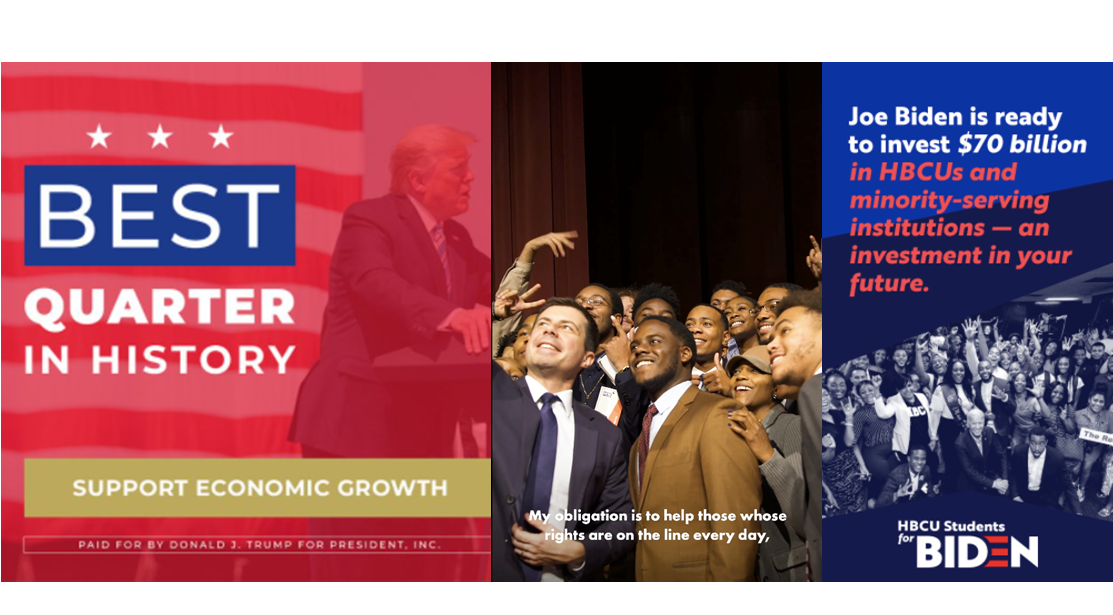Campaigns’ Facebook Ad Use Depends on Timing, Goals
Political ad campaigns on Facebook are not necessarily comparable to political ad campaigns on television, argues a newly-published article from the Wesleyan Media Project’s co-directors. In a manuscript titled, “The Influence of Goals and Timing: How Campaigns Deploy Ads on Facebook,” which appears in the Journal of Information Technology and Politics, Travis Ridout, Erika Franklin Fowler and Michael Franz suggest that political ads on Facebook pursue a variety of goals—and the goals pursued depend on the timing of the campaign.
The research examines Facebook ads placed by 24 different candidates running for U.S. Senate in 2018. The ads were tracked by Pathmatics, a commercial firm that estimates spending on political ads on Facebook, along with tracking the number of views of each ad on each day. Coders analyzed each ad, noting which of 14 different goals was pursued. These goals were collapsed into four categories: acquisition (such as signing a petition/card or answering a survey question); fundraising; mobilization (such as encouraging voting or asking people to attend a campaign event); and persuasion (such as providing information about a candidate or encouraging voting for a candidate).
The study found that 35 percent of ads focused primarily on persuasion, 31 percent focused primarily on acquisition, 21 percent focused on fundraising, 12 percent focused on something else and 2 percent focused on mobilization.
In terms of timing, the study found that acquisition is emphasized early during a campaign, but once the campaign has developed its contact list, campaigns become more focused on fundraising. In addition, information on how to vote – and encouragements to vote – are reserved for when they are needed: close to Election Day. Finally, candidates are generally positive in their ads early in the campaign but become more negative as Election Day approaches.
Ultimately, what we know about television ad use by campaigns cannot be translated directly to how they use ads on Facebook.
How Candidates’ Online Advertising Differs from Television
How does online advertising differ from television, and what are the implications for the information that citizens receive? In a newly-published article in the American Political Science Review entitled “Political Advertising Online and Offline,” Erika Franklin Fowler, Michael Franz, Gregory Martin, Zachary Peskowitz and Travis Ridout find important differences in the messages that candidates for office convey on television and on Facebook.
The study is the first comprehensive, comparative analysis of Facebook and television advertising in the 2018 U.S. midterm elections, drawing on the ad activity of all federal, statewide and state legislative candidates. The research suggests that a much broader array of candidates advertise on Facebook than on television, and this is especially true for down-ballot candidates.
The rest of the analysis focuses on within-candidate comparisons of advertising content between Facebook and TV, which enables the authors to control for factors (e.g., candidate characteristics, competition, constituency, etc.) that might otherwise bias a comparison of the two mediums. The findings suggest that Facebook advertising is less likely to contain attacks on the candidates’ opponent, less likely to focus on substantive policy issues, but more partisan in its messaging than television advertising from the same candidates.
The findings have important implications for understanding the future of political advertising. As audiences continue to move away from linear TV and toward streaming platforms, the ability of advertisers to target demographically rather than geographically will increase. As that happens, the campaigns ads that people are exposed to may become less substantive and more ideological, which could speed up partisan polarization.
Assessing Distinctive Ad Messaging in 2020 by Platform
Scholars have long acknowledged that campaigns employ different messaging strategies for each platform. Wesleyan Media Project postdoctoral research fellows Markus Neumann and Jielu Yao along with Wesleyan senior Spencer Dean ’21 led a preliminary analysis of the distinctive textual content features employed by the two presidential candidates, which was published as a contribution to an edited report on the 2020 US presidential election. In the piece, “A banner year for advertising and a look at differences across platforms,” the team reports record spending figures by both campaigns on Facebook and Google, with a surprisingly small difference between the two. Using statistical text analysis tools to assess the unique textual features of each platform, the results suggest that Facebook ads often feature negative messaging directed against the other party, while get-out-the-vote efforts where more common on Google. YouTube content meanwhile is more similar to television advertising but may be slightly more upbeat.
WMP's Delta Lab
Finally, the student researchers in WMP’s Delta Lab – a computational, student-focused research lab –have been busy conducting a variety of different types of analyses, which we are very proud to feature. Just a few highlights of their great work to date:
- Wesleyan graduate Adina Gitomer ’20 leads a network analysis of the geographic patterns of Facebook ad impressions published in Applied Network Science.
- Wesleyan senior Spencer Dean ’21 takes a deep dive into Snapchat advertising
- Wesleyan junior Roshaan Siddiqui ’22 builds a dynamic tool to help users compare Facebook advertising spending
- Wesleyan senior Angela Loyola ’21 assesses the Spanish-language advertising outreach of the Trump and Biden campaigns
- Wesleyan sophomore Natalie Appel ’23 uncovers discrepancies in the reported advertising spend by Google, similar to our tracking of Facebook discrepancies
- Wesleyan students – Sam Feuer ’23 and Natchanok ‘Pim’ Wandee ’23 and Angela Loyola ’21 – team up for an analysis of racial justice in advertising during the summer of 2020
2020 WMP End-of-Cycle Report
Click here for WMP’s report “Political Ads in 2020: Fast and Furious”




